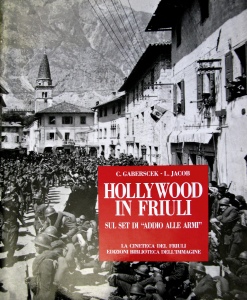When we posted about the silent film journal Griffithiana back in April 2014, about 50% of the A.G. Parker Film History Collection had been catalogued. Now about 80% has been processed. Scholars who have used the collection so far have appreciated the wide range of languages covered, and have stressed to me the scarcity and value of the many imprints from the 1920s and 1930s which are included.

The Italian component consists so far of 334 titles. Coverage of books on silent cinema is particularly strong, with a number of titles relating to the Pordenone Silent Film Festival. The earliest Italian imprint in the collection is from 1932, Introduzione a un’estetica del cinema by Alberto Consiglio (CCC.56.100). Many of these books are, of course, lavishly illustrated and of quite a large format, so they are interesting and rewarding to process. They are sometimes produced by fairly small, specialist Italian publishers, and are often not held by any other British library. One such volume which meets all these criteria is Hollywood in Friuli : sul set di Addio alle armi, published by La Cineteca del Friuli in 1991. (CCA.56.314)
In the summer of 1957 Rock Hudson and Jennifer Jones were on location in Italy to make a second film version of Ernest Hemingway’s novel A farewell to arms. Directed by Charles Vidor, this was one of the last Hollywood epics to use Italian locations, and also the last production by David Selznick. Selznick was keen to set the film where the events of the novel actually took place, in the medieval town of Venzone and the Friuli region of north-east Italy.
The earlier 1932 version of the film, directed by Frank Borzage and starring Gary Cooper and Helen Hayes, is generally more highly regarded. Halliwell describes the 1957 remake as an “elaborate ill-fated remake which tried to make an adventure epic out of a low-key war drama” and Maltin comments “over-blown, padded remake … unconvincing leads … static treatment of story”. The only Cambridge locations for the DVDs listed on LibrarySearch are Churchill College for the 1932 version and the English Faculty Library for the 1957 remake.

Hollywood in Friuli is nonetheless a fascinating publication. The authors Carlo Gaberscek and Livio Jacob have brought together a wealth of documentation, including over 200 stills and the usual memoirs and interviews with Italians who worked on the film. In addition, they have collected together and republished many contemporary newspaper articles, enabling the authors to reconstruct the social climate of the time, and describe the electrifying impact which the world of Hollywood glamour made on the local Italian population. The stills taken in Venzone have also become historically significant, since in 1976 the town was almost completely destroyed by an earthquake.
Gaberscek and Jacob later collaborated on another substantial volume on cinema in Friuli, Il Friuli e il cinema, also in the A.G. Parker Film History Collection (CCA.56.336). Neither publication has another location on COPAC.
David Lowe


excellent post, remarkable collection!
This collection is a fine addition to film books held by the University Library and by British libraries as a whole. Some of the books in the Parker collection cannot be found in other COPAC libraries (as David Lowe has indicated above) nor even in the British Film Institute library. Examples include: Hans Distel, ‘Das Kinoceros: Respekt- und Anspruchslose Verse von Filmen und vom Filmen’ (Braun & Schneider, 1957) and Giorgio Gosetti, ‘Allan Dwan: The Name Beneath the Title’ (Cinémathèque suisse, 2002). There are also many examples of Parker collection books which are only in one or two other British libraries. The UL already has one of the best selection of film books in the country, and the gift of the redoubtable Mr Parker has put Cambridge even more firmly on the ‘film studies map’.
Despite this excellent collection, however, there are many film books that remain unavailable in British libraries, especially Italian titles. Several works by Italy’s pre-eminent film historian, Aldo Bernardini, for instance, are wanting in COPAC libraries. Also some of those by Riccardo Redi, another historian of Italian cinema: for example, of his eight volumes published in the decade up to the 1995 centenary of cinema (subtitled ‘Verso il Centenario’), only three are in COPAC libraries, though it should be added that two of these are in Cambridge thanks to Mr Parker.
Here are some further examples of Italian film publications wanting in whole or part in COPAC libraries: there are no books by the film scholar Renato Bovani; no complete runs of the film journals ‘Immagine: Note di Storia del Cinema’ (ISSN: 1128-7101) or ‘Cinéma & Cie’ (ISSN 2035-5270); and only a few volumes of the proceedings of the ‘Convegno Internazionale di Studi sul Cinema’ (Udine), which have been published annually for over two decades.
Perhaps the splendid example of Mr Parker will inspire Cambridge film scholars to encourage the library to acquire more rare film books, especially those not in English and that deal with the history of the medium.
Thank you for your comments.
We have ordered a number of additional works by Bernardini and Redi, which should help fill some of the gaps that you’ve identified. If you identify any further works that you feel would complement Mr Parker’s collection, please do let us know, either here or by email.
Thank you. I’d suggest that one priority should be to acquire the journals mentioned above, for example Immagine. The earlier issues of this are now online, but a current subscription would be a good idea. http://airscnew.it/index?pid=26 The Library now has a fine collection of film history books to build on, including in Rare Books, but chiefly in South Front 5 (once the backlog has been cleared). The South Front area could become one of the leading such collections in the UK if the acquisitions policy continues to favour film and media ‘archaeology’. It is just a shame that so many eBooks are being ordered instead of real books!